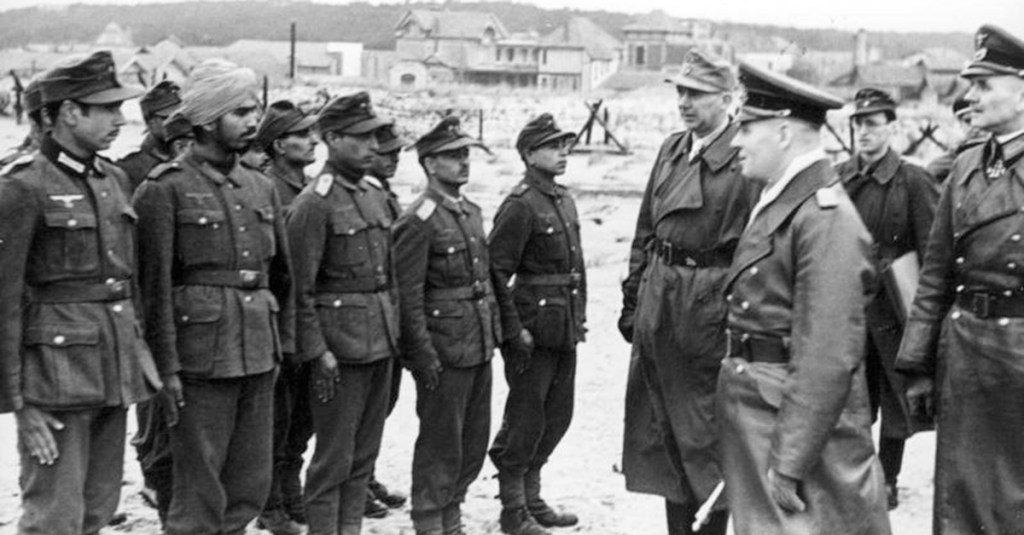During World War II, the military force aiming to install an Aryan master race over the world found potentially unlikely allies on the subcontinent of India where thousands of soldiers joined the “Free Indian Legion,” fighting on behalf of the Nazis against the Allied Powers from the China-Burma-India Theater to the Atlantic Wall on D-Day.

Hitler’s Indian Regiment
India was a British colony during World War II that sent millions of loyal subjects to fight on behalf of King George VI, but the relationship between Britain and India was strained—to say the least—when the war started. India had been agitating for independence from the East India Company and then the British Crown for about a century.
Indian troops serving Great Britain fought valiantly and earned top awards for heroism in the battle against the Axis Powers, but not all Indian leaders thought the fight against fascism should trump the fight for Indian independence. Much like American patriots in the 1770s capitalized on Britain’s fighting with France, some Indian leaders thought Britain’s war with Germany was the perfect time to break away from the crown.
And the Nazis were happy to help. When they began to take Indian troops prisoner in Africa, they offered those men German uniforms, weapons, and training if they would take up arms against the British. The first 27, all seen as potential officers, were pulled out of German POW camps and sent to Germany for training in 1941. These were soon followed by thousands of others to fill out the ranks.

An Indian independence leader, Subhas Chandra Bose, helped start the legion and got serious concessions from Germany on how the troops would be trained, deployed, equipped, paid, and more. Basically, the agreement was that the unit would be trained, paid, and equipped at the same level as any normal German unit.
But, the Indian troops could not be deployed like normal German units. The agreement that formed the unit would limit it to combat deployments focused on overthrowing British control of India. So Germany had to fund the unit like any German force, but they could only use it for Indian independence.
But still, the trade-off was seen as worthwhile by Germany as it struggled with how it would one day root British forces out of the jungles of Asia. This worry would prove well-founded when Britain and India began sending “Chindits” into the jungles to break the logistics chains and defensive lines of Japanese forces.

So the Indian Legion was formed and given a distinctive badge of a leaping tiger. But, in direct contradiction of the agreement, Indian Legion troops would go on to serve almost exclusively in Europe during the war. This wasn’t some dastardly Nazi plot though. It was simply the reality of the battlefield.
Savvy World War II buffs will remember that, while the Axis Powers were triumphantly marching across much of the world in 1941 when the legion was first recruited, it was suffering serious setbacks just a year later.
While the Indian Legion was going through initial recruitment, organization, and training, America joined the war, Polish and French resistance gained strength against Nazi occupiers, England turned back the German tide in the Battle of Britain, and America began limiting and then defeating Japan in the Pacific.
Italy, meanwhile, crumbled under the Allied assault like it was an Olive Garden.
So the Indian Legion, still in Europe for training, was sent to the Netherlands and France to get experience guarding coasts in 1943 until Germany was ready to invade through either the Soviet Union or the Middle East into India. Some Indian Legion members were still on the French coast when the Allies launched the 1944 Operation Overlord, the invasion of Fortress Europe through France.
The Indian Legion saw some combat there, but was quickly pulled from the front lines as the men complained that they would likely be executed as traitors if captured by British forces. The legion continued operations across Nazi-occupied France and Belgium and maintained some presence on the Atlantic Wall.
It suffered a few casualties against French forces, but saw little combat overall until the last of its troops deployed in France were sent to join brethren already in Italy. It was there, in Italy, that the Indian Legion surrendered to the Allies. Indian Legion members generally opted to surrender to American and French forces, but they were handed over to British and Indian forces quickly after capture.
The Indian political climate after the war had little appetite for prosecuting Indians who had worked, albeit with the Nazis, for independence. And most of the soldiers who faced court-martial saw their charges dropped or commuted.
Featured image via German Federal Archives


























